- 1Bren School of Environmental Science & Management, University of California, Santa Barbara, Santa Barbara, CA, United States
- 2University of California Cooperative Extension, Oakland, CA, United States
- 3Santa Barbara County Fire, Santa Barbara, CA, United States
- 4Community Wildfire Planning Center, Boulder, CO, United States
- 5Spatial Informatics Group - Natural Assets Lab (SIG-NAL), Santa Barbara, CA, United States
- 6Earth Research Institute, University of California, Santa Barbara, Santa Barbara, CA, United States
- 7Santa Barbara County Fire Safe Council, Santa Barbara, CA, United States
- 8Spatial Informatics Group (SIG), Pleasanton, CA, United States
There are thousands of communities and millions of homes in fire-prone wildland–urban interface (WUI) environments. Although future developments may be sited and designed to be more survivable and resistant to losses, an over-arching strategy is needed for those that are already at high risk. Traditionally, most plans for protecting WUI inhabitants focus on fuel reduction in strategic locations (e.g., defensible space around homes, fuel breaks around communities). While this approach can reduce fire hazard in specific locations and under certain weather conditions, there are a variety of vulnerabilities that are not directly addressed by fuel reduction. A more comprehensive approach is needed – one that facilitates climate change adaptation and future resilience – to mitigate multiple fire-related risks. A Regional Wildfire Mitigation Program (RWMP), expanding on traditional approaches to wildfire protection, is a key step in this direction. The goals of an RWMP include (1) retrofitting of the built environment (i.e., structural ignition vulnerabilities, water supply deficiencies, evacuation constraints); (2) buffering the landscape (i.e., a mosaic of less flammable land uses complementing traditional fuel breaks); and (3) training the community (i.e., education to become fire-adapted). We demonstrate here a consistent methodology for mapping hazards and vulnerabilities, assessing the risks of multiple negative impacts, prioritizing diverse mitigation activities, and implementing solutions that are effective and portable across many WUI environments.
Background
As fires increasingly impact human societies across the world, it is crucial that we approach complex fire-related problems as coupled social-ecological systems (Chapin et al., 2006; Berkes et al., 2008; Moritz et al., 2014; Spies et al., 2014). Focusing primarily on a narrow issue, such as fuel reduction in forests or evacuation in built environments, will only ignore the broader context and ensure future disasters. More holistic solutions are needed. In spatial terms, most losses of lives and homes tend to occur at the wildland–urban interface (WUI), where human communities are located within or adjacent to flammable landscapes (Radeloff et al., 2005; Chuvieco et al., 2014; Moritz et al., 2014; Manzello et al., 2018). Despite the uniqueness of many WUI communities, there is a quantifiable set of hazard-, vulnerability-, and exposure-related factors that characterize potential losses there. Our goal is thus to develop a consistent methodology for mapping and assessing the risks of multiple negative impacts, prioritizing diverse mitigation activities, and implementing solutions that are effective and portable across WUI environments.
Deciding where and how to build our communities – arguably the key function of land use and urban planning – has ripple effects across landscapes and feedbacks to wildfire occurrence and its impacts (Butsic et al., 2015). In fire-prone parts of France (Kocher and Butsic, 2017) and Australia (March and Rijal, 2015), current planning guidance tends to be relatively stringent, which can minimize human exposure in the most hazardous areas. In much of the world, however, the placement and layout of human developments occurred long before planning professions even existed. Many recent WUI environments have also expanded and been populated with homes that are not necessarily designed with fire resistance in mind. While new development can adopt a number of risk reduction measures to make them more survivable (Moritz and Butsic, 2020), most existing WUI communities face a massive risk mitigation challenge.
Community Wildfire Protection Plans (CWPPs) have been the dominant planning tool for safeguarding United States communities against wildfire impacts, since their inception after the Healthy Forest Restoration Act in 2003 (Society of American Foresters [SAF], 2004). In practical terms, CWPPs are often a necessary organizational step for local communities to pursue grant funding for fire hazard reduction. Studies have also found that completing a CWPP can increase social capacity and form robust stakeholder networks in fire prone communities (Jakes et al., 2007; Grayzeck-Souter et al., 2009; Jakes and Sturtevant, 2013). A study of 113 CWPPs showed, however, that some communities may expedite completion of their plans in order to gain access to funding sources; broad stakeholder input and inclusion, especially across jurisdictional boundaries, may be sacrificed as a result (Abrams et al., 2016). Shortfalls in incorporating place-based knowledge and experience, community competency, and shared responsibility and understanding may exacerbate fire effects, especially in high exposure communities (Nielsen-Pincus et al., 2019).
Although CWPPs should be collaborative and provide guidance for reducing ignitability of structures, a key output is a prioritized set of local fuel reduction treatments in a study area (Society of American Foresters [SAF], 2004). Most of the technical analysis and modeling is thus on fire behavior patterns, as opposed to mapping and prioritizing home ignition vulnerabilities. This emphasis reflects long-standing and somewhat misguided assumptions about wildland fuel reduction being able to solve the problem of homes being lost during WUI fires (Calkin et al., 2014), and it can under-emphasize the vulnerabilities of people living in those homes. Issues related to evacuations and road networks, water supplies, fire-resistant “buffers” of lower flammability (e.g., orchards or greenbelts), and homeowner training are generally beyond the scope of CWPPs and not addressed. Notably, this is an omission that is not limited to the US: Similar gaps in knowledge and emphasis have also been noted in European WUI environments (Pastor et al., 2020).
A Regional Approach
While CWPPs can play positive roles in fire planning, they have two important shortcomings: (1) their often limited spatial extents (i.e., covering a specific neighborhood or town), and (2) their lack coordination with other CWPPs in a region. Most fire-related problems must be addressed in a broader context, both spatially and conceptually (e.g., “firescapes” of Smith et al., 2016). A regional approach to wildfire mitigation, which CWPPs generally lack, is thus needed for stronger coordination.
Fire agencies in the United States have long recognized the value of a collaborative regional approach to wildfire suppression and control. Beginning in the 1970s a Mutual Aid system was developed along with a standardized command and control methodology now known as the Incident Command System (ICS). Large and/or complex wildfires can quickly overwhelm a single fire agency, but most wildfire incidents can be effectively managed by combining resources from multiple agencies operating in a common management and command structure. Fire agencies are increasingly applying this approach to vegetation management, particularly in the design of fuel break networks along WUI boundaries. Given the capability and skill set of their workforce, fire agencies typically focus on vegetation management. Removing or modifying vegetation (fuel) to slow or stop the spread of a wildland fire is the primary tactic used to contain and control wildfires (Figure 1). Fire agencies have the tools and training to implement vegetation management projects and are only limited by fiscal and environmental constraints.

Figure 1. Example of a traditional ridgetop fuel break. Such vegetation treatments are typically located to protect a specific resource and are part of a larger network of fuel breaks. (Credit: Rob Hazard).
While fuel treatments can provide significant protection to a community, they are not the sole solution. Wind-driven wildfires can loft embers many miles ahead of the main fire front, jumping over traditional fuel breaks. The built environment can thus be significantly impacted by wind-driven embers, resulting in urban conflagrations that can rapidly overwhelm firefighting resources. Evacuation of civilians then becomes the highest priority. It is clear that these issues require a wider perspective – one of “integrated fire management” (Shlisky et al., 2009; Silva et al., 2010) – which recognizes human dimensions and more than localized fuel reduction.
Three Domains of Risk
A Regional Wildfire Mitigation Program (RWMP), expanding on traditional approaches to wildfire protection, provides a holistic framework for WUI risk mitigation across broad landscapes. The goals of an RWMP include (1) retrofitting of the built environment, (2) buffering the landscape, and (3) training the community.
Resilience in the face of fire will rest on the success of mitigation efforts in all three of these domains (Figure 2). Because people move in and out of communities, landscapes evolve, and the built environment changes through time, we have designed this as an ongoing program that can adapt to meet changing needs and circumstances.
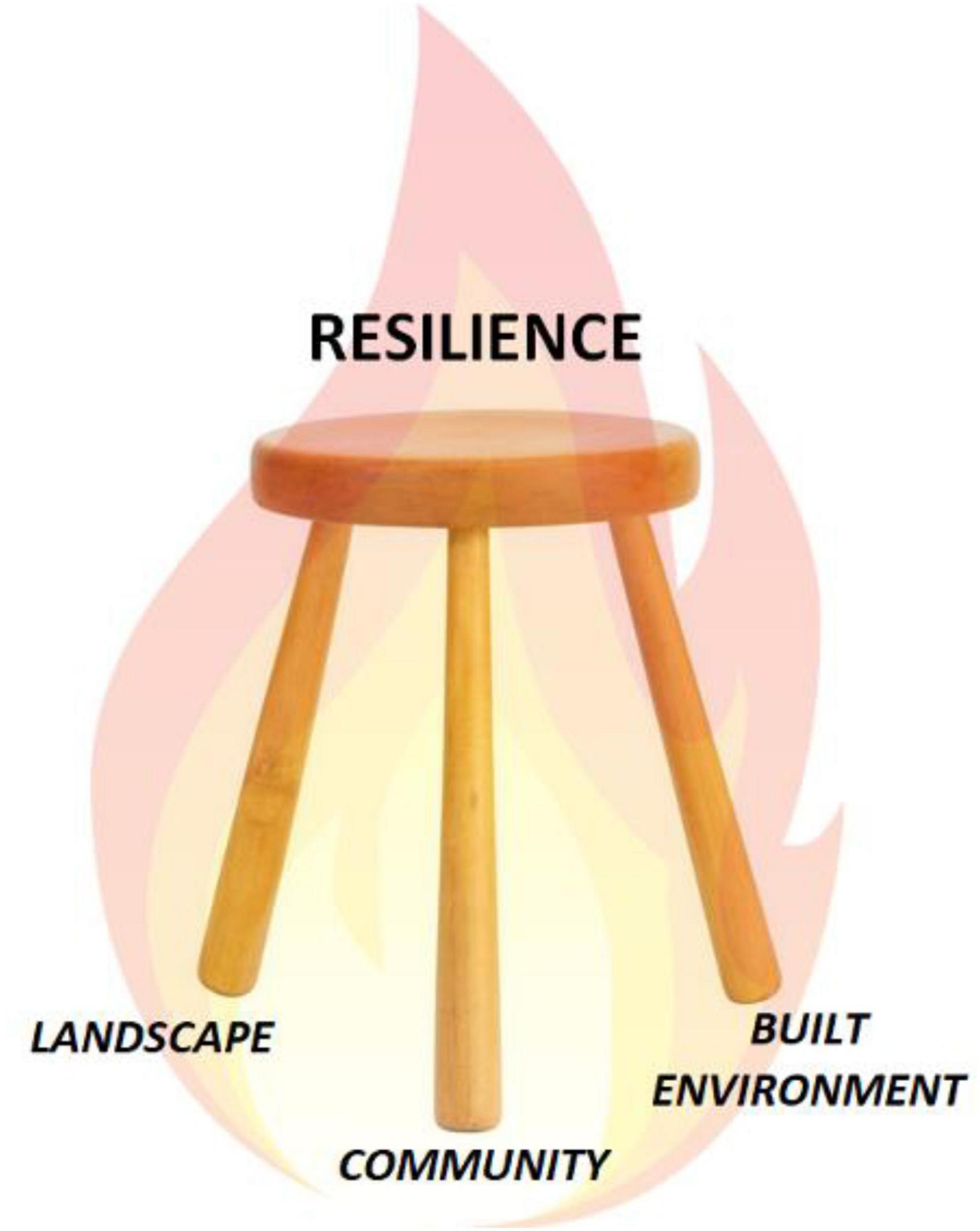
Figure 2. Wildland–urban interface (WUI) Resilience is dependent on risk mitigation in multiple domains, each with its own opportunities and challenges.
The Built Environment Domain
While existing high fire hazard building codes may mitigate structure ignitability, many older communities remain vulnerable. In particular, structural components such as attic and foundation vents, decks, and roofs are highly susceptible to ember exposure, which are typically the main cause of home ignitions. Once vulnerable structures ignite, there is the very real potential for structure-to-structure fire spread which can result in an urban conflagration (Mell et al., 2010), a condition that often overwhelms modern firefighting capability. Figure 3 highlights several of these components, demonstrating several options for mitigation at the parcel scale.
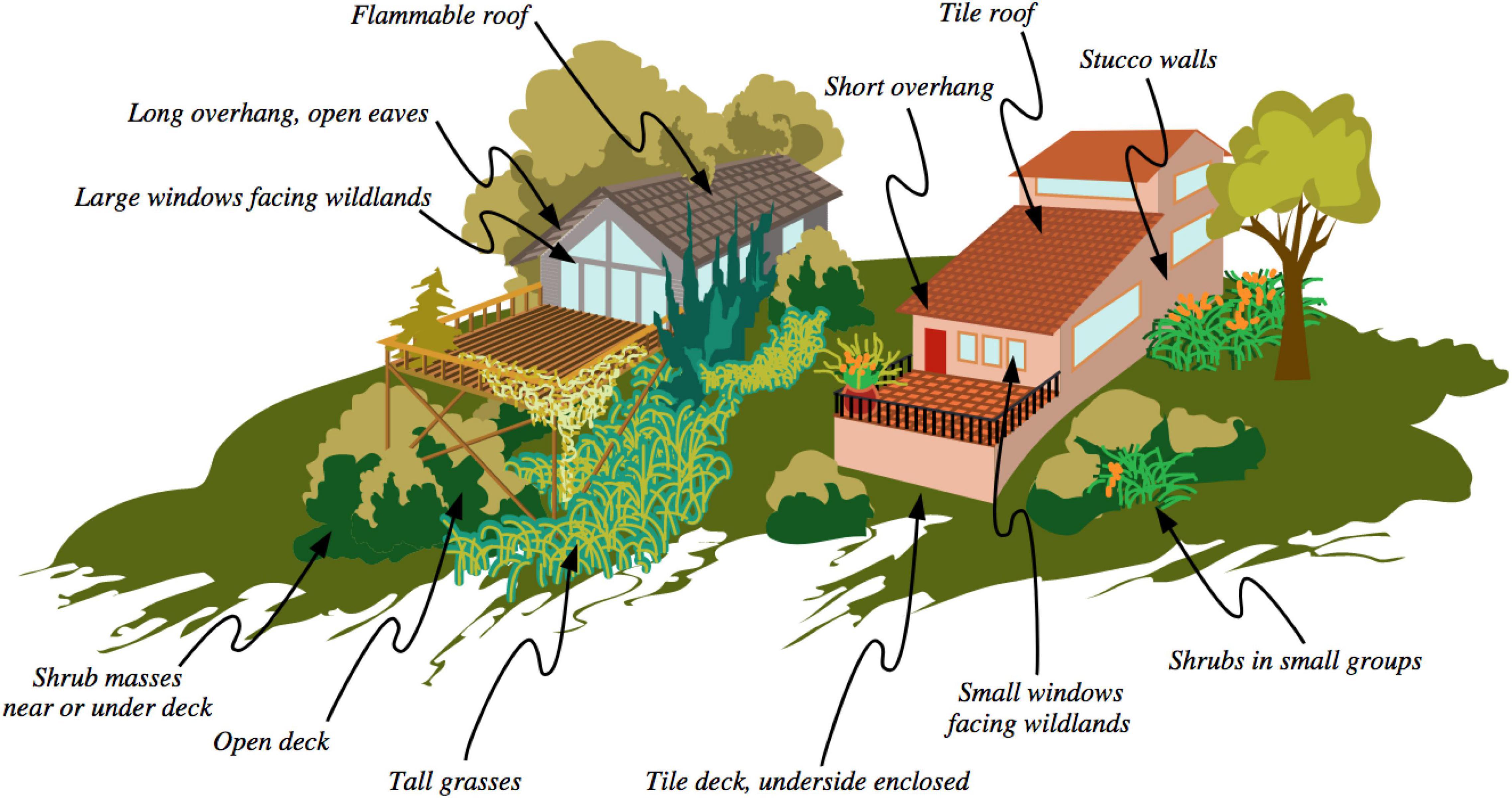
Figure 3. Comparison of homes that are relatively vulnerable (left) versus resistant (right) to ignition by wildfire. (Credit: East Bay Municipal Utility District).
Protecting critical infrastructure before a wildfire is essential to mitigate severe impacts that can affect human life and structure loss during a wildfire, in addition to reducing long-lasting repercussions on community health, safety, and economic sustainability after a wildfire. There is a variety of infrastructure that needs to be mapped and assessed for vulnerabilities in order to create a customized retrofit plan to make communities and their infrastructure more resilient to wildfires.
Water supply and distribution infrastructure is often inadequate to support fire protection needs and is also vulnerable to post-fire impacts (Writer et al., 2014; Schulze and Fischer, 2020). Water infrastructure is typically upgraded as a condition of development review. There are very few programs available to upgrade existing infrastructure in non-conforming legacy built communities. These deficiencies need to be mapped, assessed, and prioritized for improvement, and programs developed to provide funding. Improvements to water infrastructure could support implementation of active fire protection systems such as exterior sprinklers on buildings.
Many communities, especially rural communities, lack sufficient transportation networks to support evacuation needs (Cova et al., 2013; Dye et al., 2021). Of particular concern are single-access communities (one way in/out) and communities with increasing development where road infrastructure is not updated to account for increased capacity during an evacuation event. Improving the transportation infrastructure can be challenged by topography, land ownership, the adjacent built environment, and fiscal constraints. Many local governments have adapted to the latter by limiting development of new public roads in favor of private roads. While this may be a short term solution, in the long run it presents significant challenges in enforcing road standards, maintenance, and traffic codes.
The electrical grid has historically been a source of wildfire ignitions, in addition to being highly vulnerable to wildfire impact. Many significant wildfires have resulted from power line ignitions with millions of dollars of damage to the impacted communities. As a result, many utility companies and districts have initiated significant efforts to upgrade and harden electrical distribution systems. In addition, they have implemented wildfire mitigation programs, such as deploying fire weather monitoring stations and developing high resolution wildfire modeling capability, that not only help inform their operations, but also support the efforts of fire and land management agencies.
The Landscape Domain
As communities have developed into the high fire hazard areas, the need for separation from flammable wildland vegetation has become greater. While traditional fuel reduction treatments can assist this effort, they are not sufficient alone to buffer communities from the thermal impact of intense wildfires. The impacts of anthropogenic climate change are worsening this problem by increasing the intensity of wildland fire behavior. In some countries, large landscape “buffers” have proven to be effective in insulating communities from wildfire impacts (e.g., Curran et al., 2018; Cui et al., 2019). The goal of the Landscape Domain is thus to ensure a mosaic of less flammable land uses around traditional fuel breaks, by either retaining or creating buffers that slow or redirect wildfire spread.
Agricultural lands, irrigated parks and green belts, outdoor sports fields, golf courses, managed open spaces (e.g., with targeted grazing), and stands of relatively non-flammable trees and other vegetation are key land cover types to create a buffering mosaic around WUI communities (Figure 4). These areas serve as useful wildfire breaks due to a variety of factors, such high foliar moisture, routine maintenance, and/or low fuel loading.
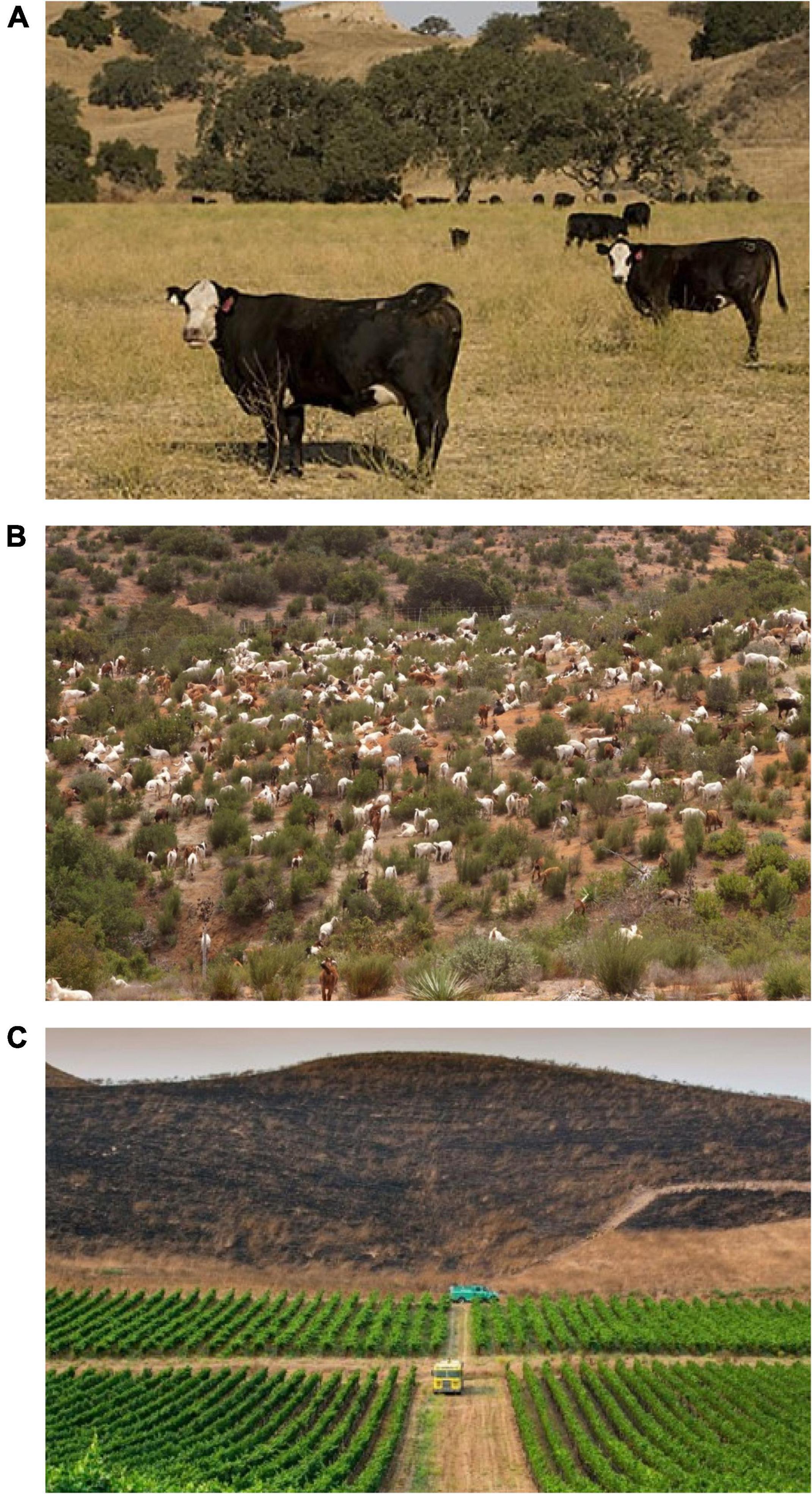
Figure 4. Potential landscape buffers against wildfire. Grazing by cattle (A) or goats (B) can lower fuel loads in open spaces that abut the WUI, increasing the chances for that portion of the landscape to halt or slow fire spread. Orchards (C) can also serve as effective barriers to wildfire in a WUI environment. (Credit: Rob Hazard).
Wildfire mitigation is often a secondary benefit for these land uses, which confer important primary amenities (livelihoods, recreation, ecosystem services, etc.) on communities where they are present. Landscape buffers may also assist efforts to restore beneficial fire to the environment through prescribed fire and managed (limited suppression) wildland fire, by reducing potential fire escapes into WUI environments. Buffering land uses are often under several intense pressures, including conversion to residential and commercial development, and water limitations. Building trust with agricultural and land conservation stakeholders is a critical task for the Landscape Domain, which will increase collaborative opportunities to retain existing land uses and add additional capacity in new areas. It is also important that landscape buffers be incorporated into local planning documents (e.g., safety elements of land use plans, multi-jurisdictional hazard mitigation plans) and local programs be adopted to encourage and fund implementation.
The Community Domain
Resident and community involvement in wildfire mitigation is essential because, unlike public lands, private lands are the responsibility of the owner (Figure 5). Educational material and outreach efforts are needed to create more social awareness about living safely in a fire-prone environment. However, effective wildfire mitigation in this domain goes beyond just education. Engaging with homeowners and promoting social capital within communities has been shown to facilitate mitigation activities (Brenkert-Smith et al., 2012). Creating personalized resources and programs are needed to assist communities with wildfire preparation; this requires a relationship between communities and local agencies or non-profits. Relationships with these groups can facilitate regulatory change or assist communities with wildfire preparation. Additionally, funding is a significant barrier to communities adopting wildfire mitigation measures such as fuels reduction around the home (McFarlane et al., 2011; McLennan et al., 2015).
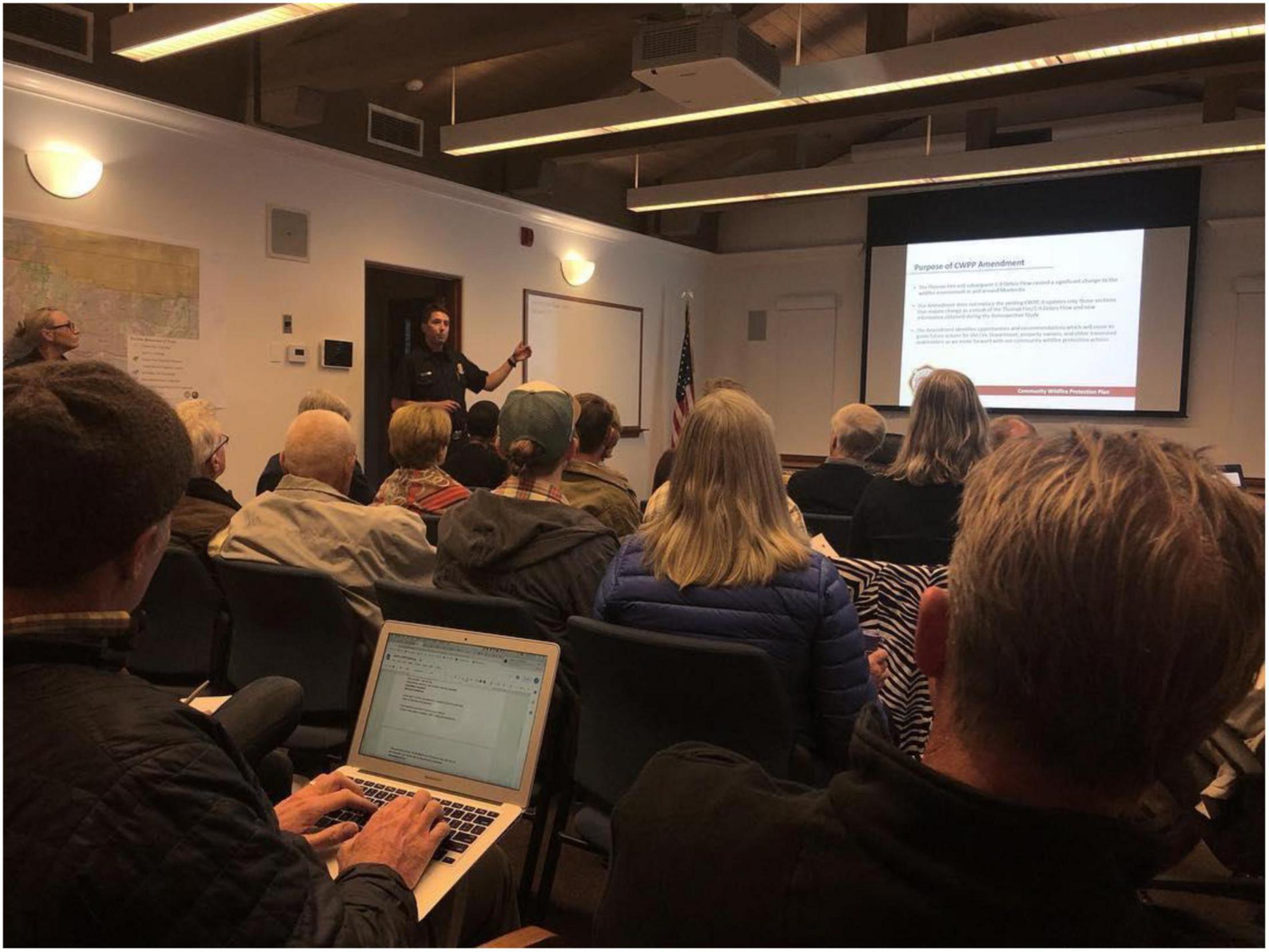
Figure 5. Community members from Montecito, CA, United States, discussing their concerns regarding wildfire with the local Fire Department at a planning meeting. (Credit: Montecito Fire District).
The Community Domain will achieve community-level resilience through activities such creating personalized training to become a fire-adapted community, hosting community events to educate the public about wildfire and wildfire preparedness, securing funding to establish community programs like a free chipping service, and advocating for local policy change to remove wildfire mitigation obstacles. There are a few programs in the United States that directly achieve many of these goals, such as the Fire Adapted Communities Learning Network1 and the Firewise USA® program hosted by the National Fire Protection Association2 (Figure 6).
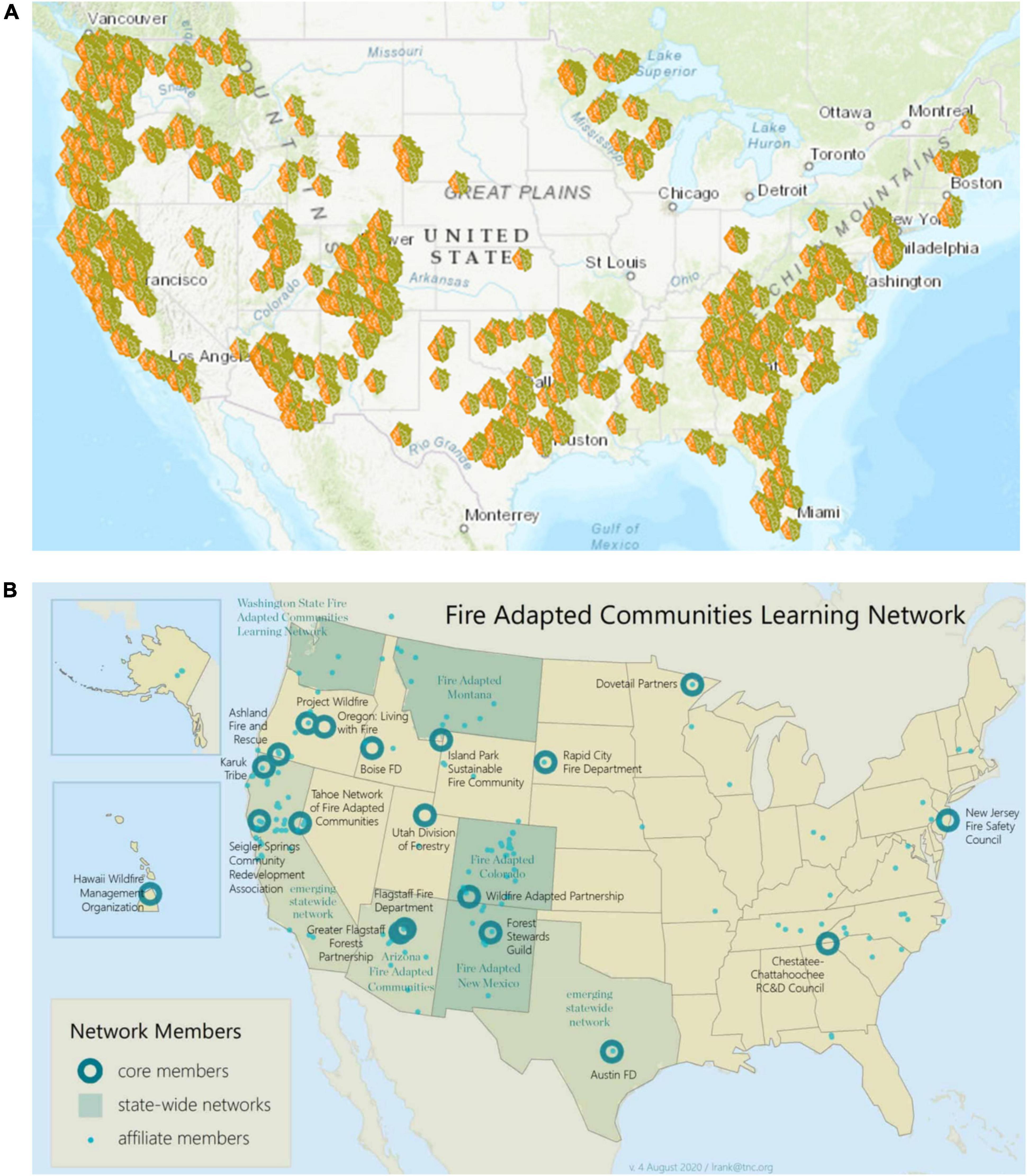
Figure 6. Community education and training networks in the United States. Firewise communities (A) as of May 2021 across the United States (www.nfpa.org/firewise). Fire Adapted Communities Learning Network (B) across the United States (www.fireadaptednetwork.org).
Importantly, the Community Domain will recognize needs of, and prioritize equitable outcomes for, socially vulnerable communities. These communities are less resilient to wildfire exposure (Davies et al., 2018) for several reasons, including emergency information that is only available in English or poorly translated (Méndez et al., 2020) and wildfire mitigation funds that are unevenly distributed to whiter and more affluent communities (Anderson et al., 2020). Such factors can increase a community’s sensitivity to impacts and reduce the ability to cope and adapt. Combating these barriers will be achieved through collaboration with local non-profits who are established as trusted sources within these communities to help them provide pre-, during, and post-wildfire assistance.
Program Structure and Phases
The RWMP provides a scalable and replicable framework for transforming WUI communities living on fire-prone landscapes, to ultimately make them more survivable and resilient by increasing community capacity to prepare, cope, and adapt to wildfire. Given the scope of the risks being mitigated, a formal structure is needed to organize activities (Figure 7). We expand on the risk assessment framework developed by Calkin et al. (2014), which explicitly recognizes home losses and the mitigation activities to lessen them. With the RWMP framework, however, there are multiple potential impacts and losses being concurrently addressed across the three domains. In terms of timing, an RWMP has three basic phases: Scoping, Implementation, and Monitoring. These phases can occur simultaneously for each of the three domains, but the intent is for work to be done collaboratively among domains (i.e., recognizing cross-domain interactions).
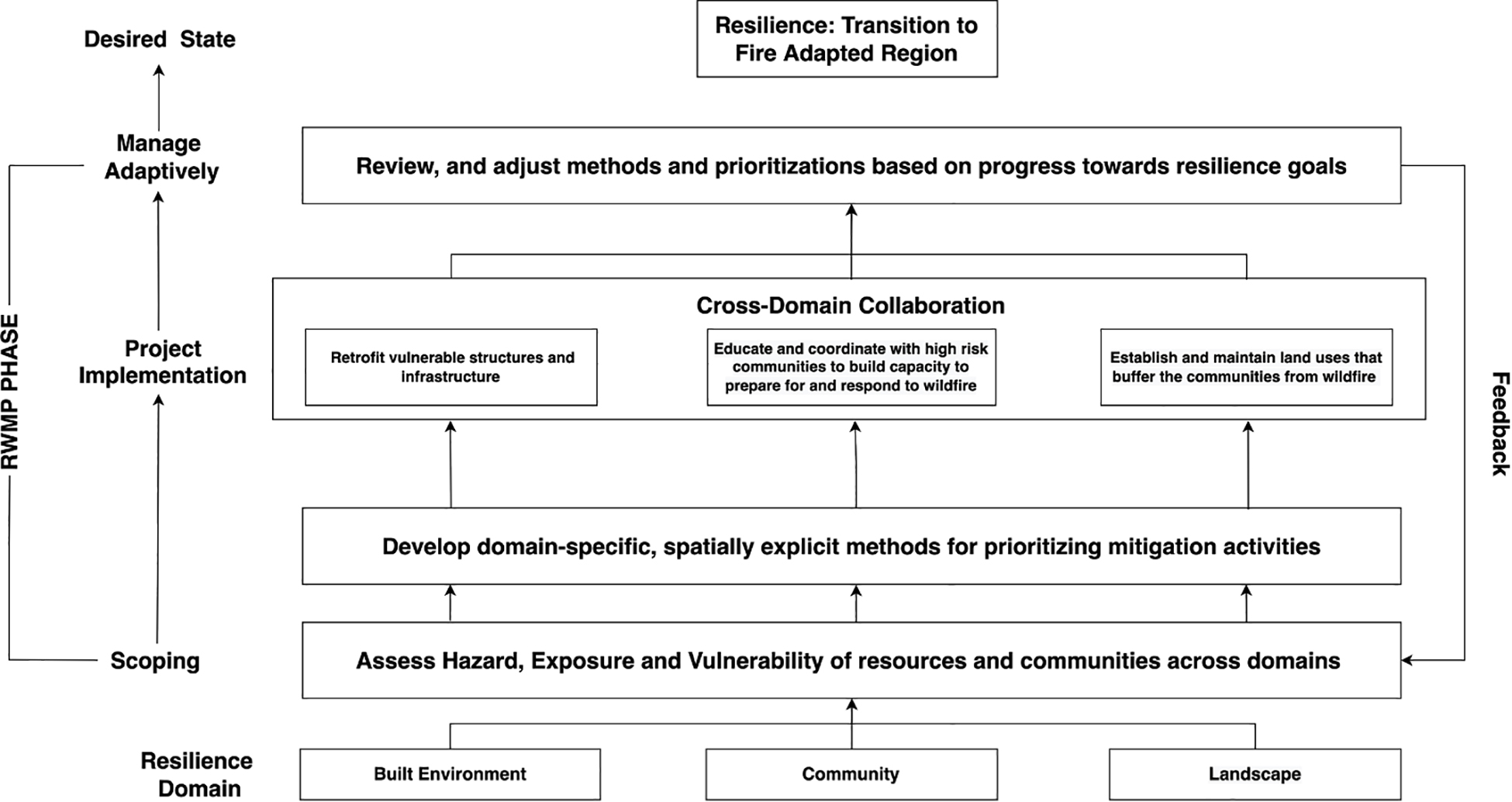
Figure 7. Regional Wildfire Mitigation Program (RWMP) structure, recognizing three domains and three phases of activity. As an ongoing program, the RWMP also needs to adapt with changing conditions and thus involves an iterative feedback loop to continuously refine risk mitigation priorities.
During the Scoping phase, the three domains work together to assess risk and prioritize projects that are suited specifically to the region of interest, with the goal of creating domain-specific implementation plans that also incorporate cross-domain partnership when applicable. To identify and evaluate mitigation activities, the RWMP will borrow from the Hazard-Vulnerability-Exposure framework of disaster risk characterization developed by the International Panel on Climate Change (IPCC, 2012) as part of their ongoing climate risk assessment. Wildfire simulations will be used to characterize the hazard (e.g., Finney et al., 2011; Scott et al., 2013, which is shared across domains. Exposure (e.g., spatial location) and vulnerability (e.g., sensitivity to impact) will be determined by gathering relevant spatial data and using field work, spatial analysis, and expert input to classify the vulnerability of high value resources in each domain (Figure 8). Site suitability analysis will be performed on the final set of prioritized mitigation activity locations, to evaluate the feasibility of different types of domain-specific activities. Examples might include whether a candidate parcel of land is best suited for targeted grazing or as an irrigated greenbelt (Landscape Domain) and whether a particular neighborhood is best served by retrofitting home ignition deficiencies or upgrading water supplies (Built Environment Domain). A full RWMP implementation plan is the net output of the multi-domain risk assessment process.
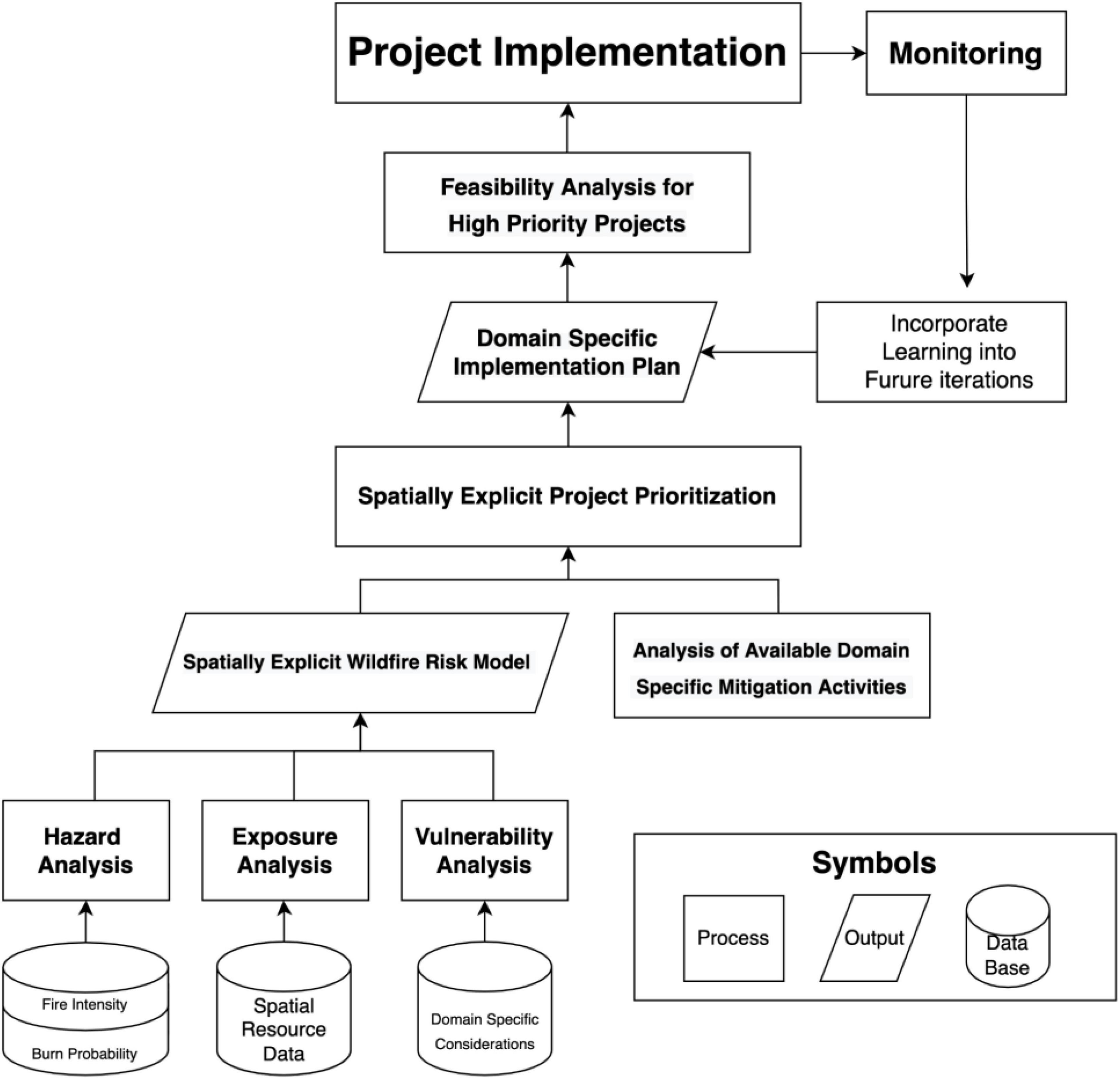
Figure 8. Regional Wildfire Mitigation Program analytical flow, ultimately creating a prioritized implementation plan for each domain.
Because there will inevitably be spatial details feeding into many of the decisions made in the RWMP risk assessment, a multi-criteria spatial optimization program like Marxan with Zones (Ardron et al., 2010) may be employed. A related approach from multi-criteria fuel reduction studies involves identification of optimal (or near-optimal) “production possibility frontier” solutions (Vogler et al., 2015), which could also integrate tradeoffs between mitigating risks of one type of loss and another (i.e., possibilities for inter- and intra-domain tradeoffs). The overall blend of projects and associated costs and benefits create an understanding of the tradeoff space that practitioners can use, based on the specific conditions of their region.
Where possible, the RWMP will favor standardized and widely accepted inputs and analyses, as opposed to developing novel methodologies. RWMPs will integrate high quality, locally vetted data inputs to provide model results with depth and granularity. Additionally, new state and even nationwide data layers are being developed that quantify different disaster risks at the parcel level. These products offer practitioners a consistent dataset across a range of regions to generate prioritizations.
In addition to a Monitoring phase to track effectiveness of RWMP efforts, we also incorporate the principles of adaptive management (Figure 7). Adjustments to project prioritization will need to be made on an intermittent basis so that mitigation activities are well suited to the continuously varying local environment and stakeholder needs. Climate change, policy shifts, development patterns and wildfires are important factors that RWMP practitioners will need to actively monitor to determine if changes in selection criteria are needed.
Moving Forward: The RWMP of Santa Barbara County, California
In 2021, the Santa Barbara County RWMP began work across the coastal WUI region shown in Figure 9. The south coast of Santa Barbara County is a classic WUI environment, with urban, suburban and exurban areas abutting and intermixing with Los Padres National Forest land dominated by fire-prone chaparral vegetation. The region has an active fire regime and significant history of catastrophic fires during the past few decades.
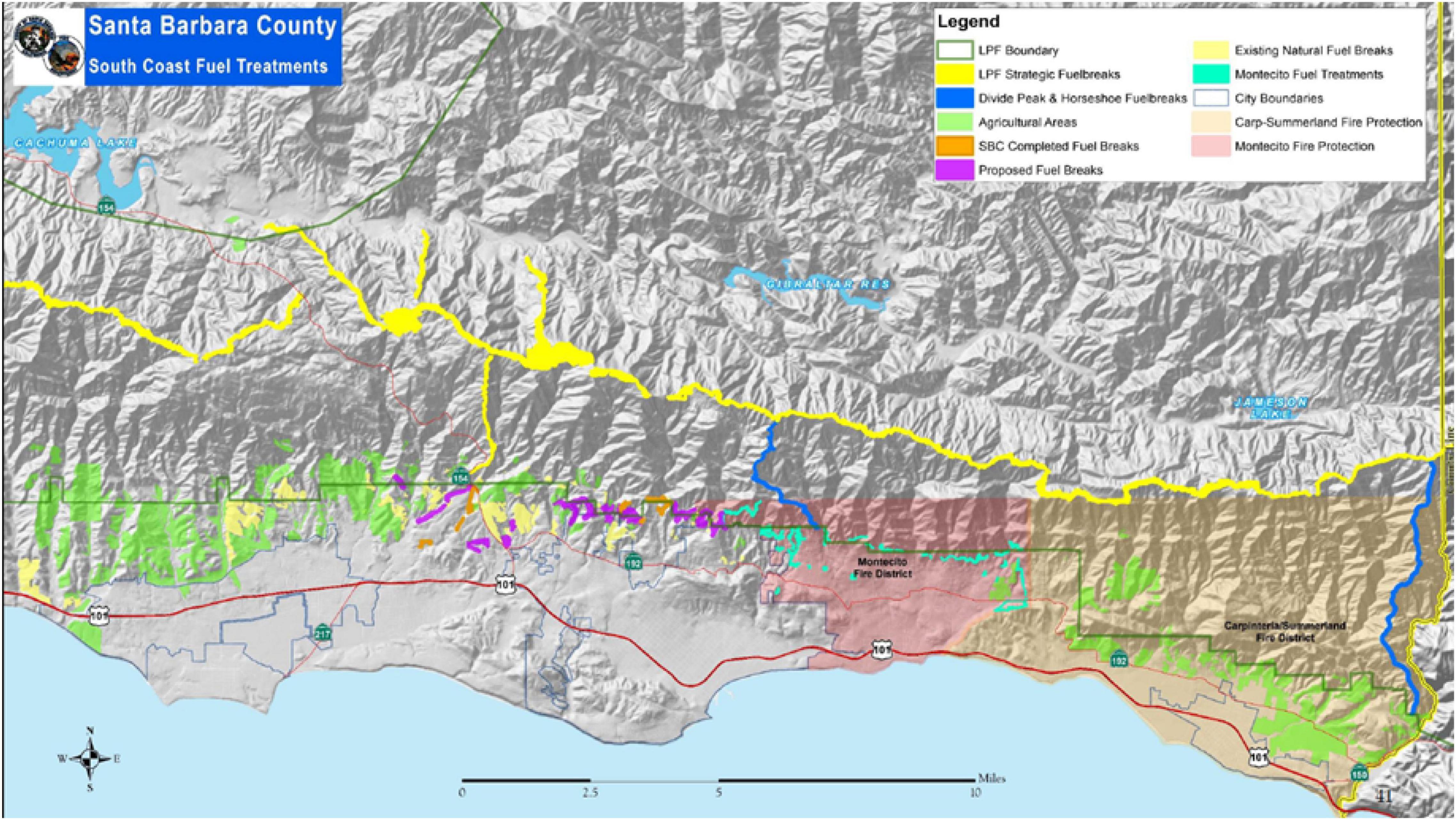
Figure 9. Santa Barbara, CA, United States, showing different fuel types and treatments in a portion of the first RWMP. Note that there are still agricultural lands that act as a buffer against fire in eastern and western portions of the RWMP study area; they are missing now in the central portion of this map, and this is historically where home losses occur. Most of the flatter areas by the coast are heavily developed, with ample opportunities for retrofits to the built environment and training for communities. (See https://rwmpsantabarbara.org/ for additional information).
Within its first year, the Santa Barbara RWMP has yielded a variety of insights and initial results. Below we summarize examples from each of the RWMP domains, demonstrate initial cross-domain risk assessment findings, and provide overall lessons that should apply to future RWMPs and other climate change adaptation efforts at comparable regional scales.
Domain-Specific Examples
Built Environment
The focus of this RWMP has expanded to include homes, businesses, roads, schools, hospitals, fire stations, and electrical, telecommunications, and water infrastructure. To create maps of these resources at risk, the Built Environment Domain has aggregated products from agencies that map wildfire hazard, generate post-fire damage assessment reports, perform defensible space inspections, control land use, and identify critical infrastructure conditions. Ground truthing and local knowledge are also being incorporated into this process through field visits and interviews with local planning and Fire Departments/Districts. To complement this work, the Built Environment Domain has undertaken an in-depth analysis of the regulatory framework of local planning and public works processes. Analyses seek to understand existing gaps or opportunities in the framework, to further support policies and regulations that improve wildfire resilience. Work to date draws on numerous peer-reviewed academic and professional articles, as well as planning documents from governmental and non-governmental organization (Supplementary Table 1).
During the team’s initial assessment phase, the Built Environment Domain explored cross-domain implications and collaboration. For example, field visits and research revealed several communities with well-organized wildfire mitigation and protection services, largely through the Wildland Resident Association3 (WRA). Some of these relatively remote communities also perform extensive annual vegetation management and already coordinate their own volunteer fire department. However, these communities also struggle with access to reliable telecommunication services, and electrical and water infrastructure—all of which could support increased wildfire resilience.
These challenges and opportunities highlight the overlap between potential outcomes for both the Built Environment and Community Domain. The Community Domain may support building capacity for ongoing wildfire mitigation projects, while the Built Environment Domain can recommend policies or programs that would improve access to reliable and efficient utility infrastructure. There is also potential for the Built Environment Domain to collaborate with the Landscape Domain on broad policies as they relate to farm structures, including farm worker housing. Additionally, the Landscape Domain offers support for broader landscape-scale fuel management projects surrounding rural infrastructure and communities. Other points of possible collaboration include resilience hubs, defensible space data collection, and water infrastructure, which continue to be explored.
Landscape Domain
Because risk mitigation projects in the Landscape Domain embody the larger principles of landscape resilience, the RWMP has entered into a pre-existing system of local and regional non-governmental organizations (NGOs) working toward the same goal. While this created competition between organizations in early stages, through relationship building and collaboration, the RMWP has become embedded into the local system and is seen as an important collaborator. It has also been crucial to tailor the messaging around the trade-offs and synergies between more traditional fuel reduction methods and resiliency-oriented methods, when meeting with different stakeholder groups.
Several inherent advantages have emerged for the Landscape Domain, due to the broad scale of the mitigation options being considered. Proposed project types such as restored riparian areas and shaded fuel breaks could have regional ecological and hydrological benefits, in addition to acting as buffers against oncoming wildfires. Implementation of these “nature-based” solutions has also allowed collaboration with a new set of stakeholders, such as multi-benefit resilience projects that help agricultural livelihoods in need of new opportunities. By working closely with these organizations, the work carried out as part of the RWMP will be lasting and impactful far into the future.
Other Landscape Domain findings have been relatively local in nature, depending on specifics of our biogeographic location. For example, the most promising native tree for use in evergreen shaded fuel break buffers appears to be coast live oak (Quercus agrifolia). Working with the Santa Barbara Botanic Garden has therefore been a good fit for progress in this area (i.e., identifying best practices and locations for establishing stands of trees).
Community Domain
Enrolling communities into the Firewise USA® program has become one of the main objectives of the Community Domain in the study area. Firewise helps to create fire-adapted communities by establishing a framework for communities to get organized, learn about their wildfire risk, and mitigate their risk. Through the Firewise process, communities are empowered by learning about their local fire history and threats, fostering and strengthening social capital, building connections with local fire agencies, government officials, and non-profits, such as Fire Safe Councils, and laying out a pathway for the community to work together to mitigate their fire vulnerabilities. Before any education and training can occur, however, individual communities must be mapped and engaged.
Local communities are being identified and motivated by leveraging existing connections within the RWMP stakeholders and neighborhoods in the study area. The spatial boundaries of what a “community” actually is and how many people are enough (or too many) are not always clear. Activities started with communities that already have a strong organizational system in place, since this system has a built-in hierarchical and operational structure, such as an informal neighborhood committee or a homeowner’s association (HOA). Such a system provides a decision-making structure that has recognized community leaders. Identifying those key leaders within a community is thus a core component of success, as they can help organize (e.g., set up community meetings), disseminate information to the rest of the community, and ensure the community follows through on important tasks (e.g., completing Firewise enrollment and attaining official recognition).
An ongoing challenge will be engaging with communities, particularly those that are socio-economically vulnerable, that do not have an established formal or informal neighborhood committee. To organize and engage these communities, several questions have arisen: How does a community define itself? How should these communities be approached, and who should be contacted? Because community dynamics can be very sensitive, education and training activities can face immediate roadblocks if natural leaders are not apparent. For the Santa Barbara County RWMP, roughly half of the WUI has been mapped and aggregated into community-based units (e.g., see upcoming Figure 10) to date.
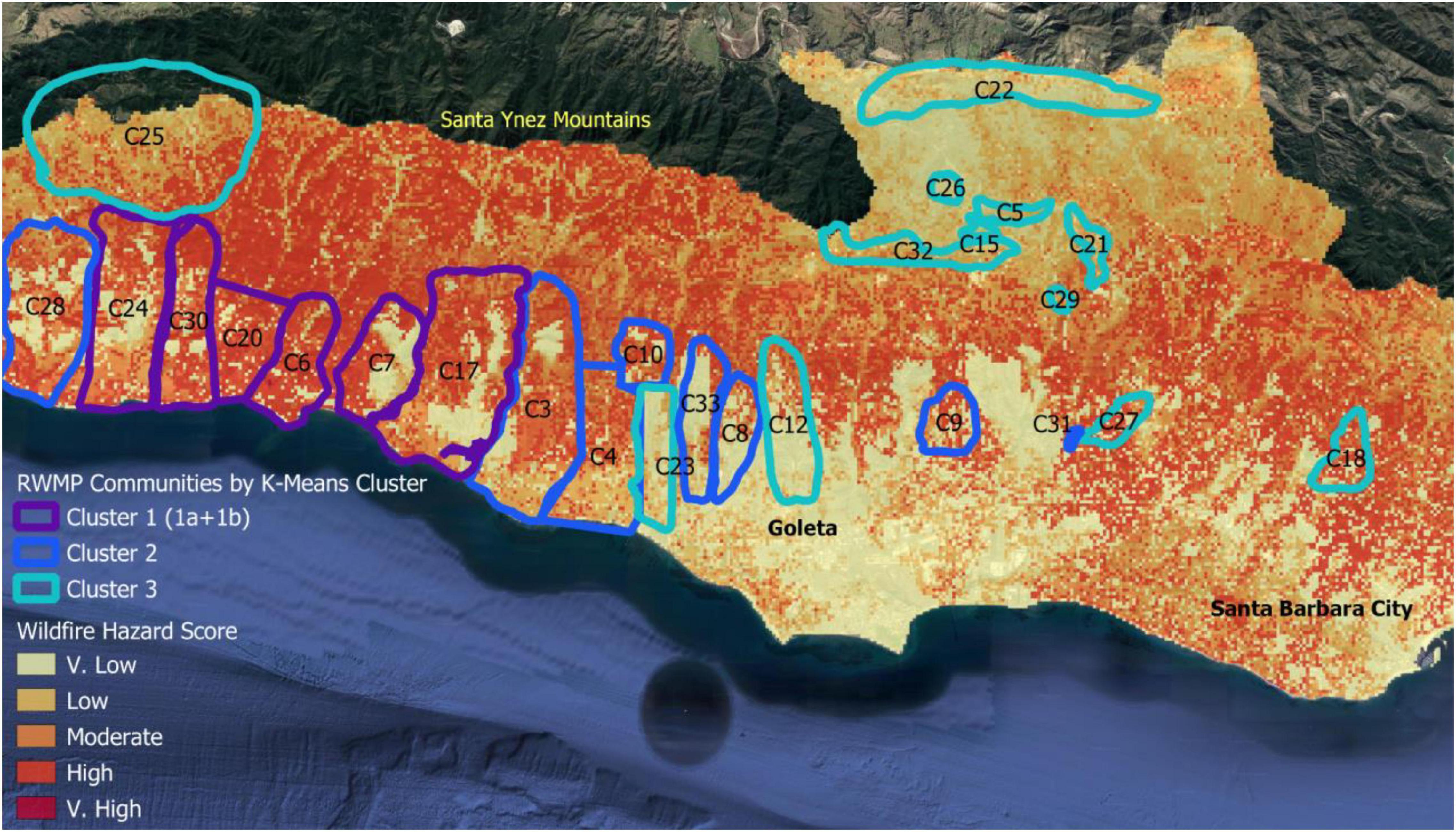
Figure 10. Wildfire hazard map and community areas of the Santa Barbara RWMP region. Map is a subset of the total RWMP project area. The yellow–red color scale indicates wildfire hazards according to quantile at 90 m pixel areas. RWMP community areas are drawn with colored outlines showing their designation to three groups of general wildfire hazard, vegetation conditions, and structure adaptation levels, identified by K-means cluster analyses of field survey and satellite data (see Supplementary Table 2 and Supplementary Figure 1).
Cross-Domain Risk Assessment: Early Activities and Findings
A core part of the Santa Barbara RWMP is to produce new quantitative analyses that improve wildfire hazard characterization and inform mitigation activity prioritization at a regional scale, integrating across many community areas. Strong collaborations among researchers, environmental analysts, fire professionals and local governments have facilitated the collection of diverse, interdisciplinary, and cross-professional datasets. Datasets include satellite imagery archives, high-resolution climate data reanalyses, and property defensible space surveys by Santa Barbara County Fire and other fire departments. Our analyses include wildfire modeling and hazard assessment with advanced spatial meteorological data (Jones et al., 2021), remote sensing of vegetation and landscape conditions to inform green buffer enhancement via vegetation and water management (e.g., Mayes et al., 2020), and synthetic assessments of wildfire hazard, environmental conditions, and vulnerability indicators across a larger region that resolve community-level conditions.
As an example of synthetic assessment, we report here preliminary statistical analyses (principal components and unsupervised K-means cluster analyses, e.g., Javadi et al., 2017) that assigns community areas into generalized groups of wildfire hazard severity levels and adaptation status, based on multi-variable indicator sets. In initial analyses, the indicator variable set included wildfire hazard scores, landscape vegetation conditions (canopy moisture), and two built environment vulnerability indicators (average percentage of structures within community areas with fire-resistant roofing and siding; Figure 10; also see Supplementary Table 2 and Supplementary Figure 1). Biophysical variables accounted for the greatest proportion of variability (48%) followed by the structure-related variables (24.5%) (Supplementary Figure 1). Clusters 1–3 (in order) corresponded generally with highest to more modest wildfire hazard scores (and lowest to highest vegetation moisture, respectively). Cluster 2 identified community areas with both relatively high wildfire hazard and the highest ignition potentials of built environmental structures. From local knowledge, cluster 2 corresponds with communities with high proportions of agricultural and other properties with older wooden structures devoted to worker housing.
While these initial results are not a formal optimization across multiple risks, they illustrate the utility of mapping community areas by cluster membership against wildfire hazards in this manner: they succinctly identify patterns in wildfire hazard severity and vulnerability across a complex region (Figure 10). Such patterns will help the RWMP prioritize attention in terms of education, outreach or funding to communities that need the most help for wildfire hazard mitigation. New data for hazard, exposure, and/or vulnerability in a given domain will also refine these priorities as the RWMP continues.
Transferrable Insights
At the start of the Santa Barbara RWMP, creation of common wildfire hazard maps faced challenges in communication among team members with different scientific and professional backgrounds. Specifically, some had trouble moving from a) conceptual discussion of project goals and desired outputs (e.g., updated wildfire hazard maps) to b) identifying how experts from different disciplines needed to collaborate to accomplish precise steps for technical analyses, such as wildfire hazard modeling.
To surmount these challenges, two aspects of project planning are clear. The first aspect is to plan project work “backwards” as a team, starting from definitions of final products. Envision goals and forms of project outputs with “blue-sky” thinking but concrete terms (e.g., unified or single implementation plan documents for each domain; hazard maps, risk assessments). Keep conceptual discussions grounded; early in the sequence of project work, discuss and agree upon physical parameters and technical specifications of project outputs (e.g., spatial domain of analyses, units, spatial resolution, scales of reporting areas such county assessor parcels versus watershed areas).
The second aspect is to plan how to work together. This means identifying and assigning roles in collaborative processes that cross-professional team members, often based at different entities (e.g., consulting firms, universities, non-profits, local government organizations), will need to fill individually and together (e.g., in sub-groups) to achieve the final products. An important role is that of technical translating and data management between different scientific fields (e.g., climatology and fire modeling). Efficient technical translating is an example of “open communication”, wherein practitioners from different backgrounds may not fully understand each others’ fields or technical jargon, but they carry out precise, common-language discussion to identify technical barriers to synthetic analyses across their fields and plan how to tackle them (Winowiecki et al., 2011).
As noted above, some overlap exists among the three domains, highlighting the importance of cross-domain communication and coordination in our conceptual framework (Figures 7, 8). The difference between creating a “plan” and an active “program” – namely the “P” in RWMP – has also become very clear. Because the work of becoming and remaining resilient to WUI fires will never really be finished, a local group must adopt the ongoing responsibility of refining and implementing the prioritized mitigation activities identified through the RWMP. This leadership should be identified early in the program, so that continued funding and progress can be achieved.
Conclusion
Although fire hazard does not appear to be lessening anytime soon in most WUI environments, there is growing recognition that holistic solutions to these complex socio-ecological problems are urgently needed. Multiple risks need to be mitigated, and they involve hazards, exposures, and vulnerabilities across large landscapes. Thousands of communities and millions of people are affected, and the numbers only grow as the WUI continues to expand. In hopes of offering a more comprehensive approach, we have presented the concept of the Regional Wildfire Mitigation Program, which involves three domains of activity and their interactions. Initial findings from the Santa Barbara County RWMP are also shared, demonstrating early successes and lessons learned so far. The RWMP builds on traditional approaches to wildfire protection, uses a consistent methodology for assessing risk and mitigation priorities, and should be portable to additional WUI developments in different environments.
Data Availability Statement
Additional analytical details on the study are included in the article/Supplementary Material, further inquiries can be directed to the corresponding author/s.
Author Contributions
MAM designed the study and wrote most of the manuscript. RH, KJ, MMa, MMo, KO, A-MP, DS, and GW contributed analyses and also helped to write the manuscript. All authors contributed to the article and approved the submitted version.
Conflict of Interest
The authors declare that the research was conducted in the absence of any commercial or financial relationships that could be construed as a potential conflict of interest.
Publisher’s Note
All claims expressed in this article are solely those of the authors and do not necessarily represent those of their affiliated organizations, or those of the publisher, the editors and the reviewers. Any product that may be evaluated in this article, or claim that may be made by its manufacturer, is not guaranteed or endorsed by the publisher.
Acknowledgments
The authors are grateful for support from the National Fish and Wildlife Foundation’s Emergency Coastal Resilience Fund.
Supplementary Material
The Supplementary Material for this article can be found online at: https://www.frontiersin.org/articles/10.3389/ffgc.2022.848254/full#supplementary-material
Footnotes
References
Abrams, J., Nielsen-Pincus, M., Paveglio, T., and Moseley, C. (2016). Community wildfire protection planning in the American West: homogeneity within diversity? J. Environ. Plan. Manage. 59, 557–572. doi: 10.1080/09640568.2015.1030498
Anderson, S., Plantinga, A., and Wibbenmeyer, M. (2020). Inequality in Agency Responsiveness: Evidence from Salient Wildfire Events. Resources for the Future, Working Paper 20–22, Washington, DC.
Ardron, J. A., Possingham, H. P., and Klein, C. J. (2010). Marxan Good Practices Handbook, Version 2. Victoria, BC, Canada: Pacific Marine Analysis and Research Association, 165.
Berkes, F., Colding, J., and Folke, C. (2008). Navigating Social-Ecological Systems: Building Resilience for Complexity and Change. Cambridge: Cambridge University Press.
Brenkert-Smith, H., Champ, P. A., and Flores, N. (2012). Trying not to get burned: understanding homeowners’ wildfire risk-mitigation behaviors. Environ. Manage. 50, 1139–1151. doi: 10.1007/s00267-012-9949-8
Butsic, V., Kelly, M., and Moritz, M. A. (2015). Land use and wildfire: a review of local interactions and teleconnections. Land 4, 140–156. doi: 10.3390/land4010140
Calkin, D. E., Cohen, J. D., Finney, M. A., and Thompson, M. P. (2014). How risk management can prevent future wildfire disasters in the wildland-urban interface. Proc. Natl. Acad. Sci. 111, 746–751. doi: 10.1073/pnas.1315088111
Chapin, F. S. III, Robards, M. D., Huntington, H. P., Johnstone, J. F., Trainor, S. F., Kofinas, G. P., et al. (2006). Directional changes in ecological communities and social-ecological systems: a framework for prediction based on Alaskan examples. Am. Nat. 168, S36–S49. doi: 10.1086/509047
Chuvieco, E., Martínez, S., Román, M. V., Hantson, S., and Pettinari, M. L. (2014). Integration of ecological and socio-economic factors to assess global vulnerability to wildfire. Glob. Ecol. Biogeogr. 23, 245–258. doi: 10.1111/geb.12095
Cova, T. J., Theobald, D. M., Norman, J. B., and Siebeneck, L. K. (2013). Mapping wildfire evacuation vulnerability in the western US: the limits of infrastructure. GeoJournal 78, 273–285. doi: 10.1007/s10708-011-9419-5
Cui, X., Alam, M. A., Perry, G. L., Paterson, A. M., Wyse, S. V., and Curran, T. J. (2019). Green firebreaks as a management tool for wildfires: lessons from China. J. Environ. Manage. 233, 329–336. doi: 10.1016/j.jenvman.2018.12.043
Curran, T. J., Perry, G. L., Wyse, S. V., and Alam, M. A. (2018). Managing fire and biodiversity in the wildland-urban interface: a role for green firebreaks. Fire 1:3. doi: 10.3390/fire1010003
Davies, I. P., Haugo, R. D., Robertson, J. C., and Levin, P. S. (2018). The unequal vulnerability of communities of color to wildfire. PLoS One 13:e0205825. doi: 10.1371/journal.pone.0205825
Dye, A. W., Kim, J. B., McEvoy, A., Fang, F., and Riley, K. L. (2021). Evaluating rural Pacific Northwest towns for wildfire evacuation vulnerability. Nat. Hazards 107, 911–935. doi: 10.1007/s11069-021-04615-x
Finney, M. A., McHugh, C. W., Grenfell, I. C., Riley, K. L., and Short, K. C. (2011). A simulation of probabilistic wildfire risk components for the continental United States. Stochastic Environ. Res. Risk Assess. 25, 973–1000. doi: 10.1007/s00477-011-0462-z
Grayzeck-Souter, S. A., Nelson, K. C., Brummel, R. F., Jakes, P., and Williams, D. R. (2009). Interpreting federal policy at the local level: the wildland–urban interface concept in wildfire protection planning in the eastern United States. Int. J. Wildland Fire 18, 278–289. doi: 10.1071/wf08081
IPCC (2012). “Summary for Policymakers,” in Managing the Risks of Extreme Events and Disasters to Advance Climate Change Adaptation. A Special Report of Working Groups I and II of the Intergovernmental Panel on Climate Change, eds C. B. V. Field, T. F. Barros, D. Stocker, D. J. Qin, K. L. Dokken, M. D. Ebi, et al. (Cambridge, UK: Cambridge University Press), 3–21.
Jakes, P. J., and Sturtevant, V. (2013). Trial by fire: community wildfire protection plans put to the test. Int. J. Wildland Fire 22, 1134–1143. doi: 10.1071/wf12156
Jakes, P., Burns, S., Cheng, A., Saeli, E., Brummel, K. N. R., Grayzeck, S., et al. (2007). “Critical elements in the development and implementation of community wildfire protection plans (CWPPs),” in The fire environment–innovations, management, and policy; conference proceedings. 26-30 March 2007; Destin, FL. Proceedings RMRS-P-46CD, eds B. W. Butler and W. Cook (Fort Collins, CO: US Department of Agriculture). 46, 613–624.
Javadi, S., Hashemy, S. M., Mohammadi, K., Howard, K. W. F., and Neshat, A. (2017). Classification of aquifer vulnerability using K-means cluster analysis. J. Hydrol. 549, 27–37. doi: 10.1016/j.jhydrol.2017.03.060
Jones, C., Carvalho, L. M., Duine, G. J., and Zigner, K. (2021). Climatology of Sundowner winds in coastal Santa Barbara, California, based on 30 yr high resolution WRF downscaling. Atmos. Res. 249:105305. doi: 10.1016/j.atmosres.2020.105305
Kocher, S. D., and Butsic, V. (2017). Governance of land use planning to reduce fire risk to homes Mediterranean France and California. Land 6:24. doi: 10.3390/land6020024
Manzello, S. L., Blanchi, R., Gollner, M. J., Gorham, D., McAllister, S., Pastor, E., et al. (2018). Summary of workshop large outdoor fires and the built environment. Fire Safe. J. 100, 76–92. doi: 10.1016/j.firesaf.2018.07.002
March, A., and Rijal, Y. (2015). Reducing bushfire risk by planning and design: a professional focus. Plan. Practice Res. 30, 33–53. doi: 10.1080/02697459.2014.937138
Mayes, M., Caylor, K. K., Singer, M. B., Stella, J. C., Roberts, D., and Nagler, P. (2020). Climate sensitivity of water use by riparian woodlands at landscape scales. Hydrol. Process. 34, 4884–4903. doi: 10.1002/hyp.13942
McFarlane, B. L., McGee, T. K., and Faulkner, H. (2011). Complexity of homeowner wildfire risk mitigation: an integration of hazard theories. Int. J. Wildl. Fire 20, 921–931. doi: 10.1071/wf10096
McLennan, J., Paton, D., and Wright, L. (2015). At-risk householders’ responses to potential and actual bushfire threat: an analysis of findings from seven Australian post-bushfire interview studies 2009–2014. Int. J. Disaster Risk Reduct 12, 319–327. doi: 10.1016/j.ijdrr.2015.02.007
Mell, W. E., Manzello, S. L., Maranghides, A., Butry, D., and Rehm, R. G. (2010). The wildland–urban interface fire problem–current approaches and research needs. Int. J. Wildl. Fire 19, 238–251. doi: 10.1071/wf07131
Méndez, M., Flores-Haro, G., and Zucker, L. (2020). The (in) visible victims of disaster: understanding the vulnerability of undocumented Latino/a and indigenous immigrants. Geoforum 116, 50–62. doi: 10.1016/j.geoforum.2020.07.007
Moritz, M. A., and Butsic, V. (2020). Building To Coexist With Fire: Community Risk Reduction Measures For New Development In California. UC ANR Publication 8680.
Moritz, M. A., Batllori, E., Bradstock, R. A., Gill, A. M., Handmer, J., Hessburg, P. F., et al. (2014). Learning to coexist with wildfire. Nature 515, 58–66. doi: 10.1038/nature13946
Nielsen-Pincus, M., Evers, C., and Ager, A. (2019). Exposure Complexity and Community Capacity to Manage Wildfire Risk: A Coupled Biophysical and Social Analysis of 60 Communities in the Western United States. Fire 2:59. doi: 10.3390/fire2040059
Pastor, E., Muñoz, J. A., Caballero, D., Àgueda, A., Dalmau, F., and Planas, E. (2020). Wildland–Urban interface fires in Spain: summary of the policy framework and recommendations for improvement. Fire Technol. 56, 1831–1851. doi: 10.1007/s10694-019-00883-z
Radeloff, V. C., Hammer, R. B., Stewart, S. I., Fried, J. S., Holcomb, S. S., and McKeefry, J. F. (2005). The wildland–urban interface in the United States. Ecol. Appl. 15, 799–805.
Schulze, S. S., and Fischer, E. C. (2020). Prediction of water distribution system contamination based on wildfire burn severity in wildland urban interface communities. ACS EST Water 1, 291–299. doi: 10.1021/acsestwater.0c00073
Scott, J. H., Thompson, M. P., and Calkin, D. E. (2013). A wildfire risk assessment framework for land and resource management. Gen. Tech. Rep. 83:315.
Shlisky, A., Alencar, A. A. C., Nolasco, M. M., and Curran, L. M. (2009). “Overview: Global fire regime conditions, threats, and opportunities for fire management in the tropics,” in Tropical Fire Ecology, (Berlin: Springer Praxis Books), doi: 10.1007/978-3-540-77381-8_3
Silva, J. S., Rego, F. C., Fernandes, P., and Rigolot, E. (2010). Towards integrated fire management. Outcomes of the European Project Fire Paradox. Research Report 23. Joensuu, Finland: European Forest Institute, 229.
Smith, A. M., Kolden, C. A., Paveglio, T. B., Cochrane, M. A., Bowman, D. M., Moritz, M. A., et al. (2016). The science of firescapes: achieving fire-resilient communities. Bioscience 66, 130–146. doi: 10.1093/biosci/biv182
Society of American Foresters [SAF] (2004). Preparing a Community Wildfire Protection Plan: A Handbook for Wildland-Urban Interface Communities. Bethesda, MD: Society of American Foresters.
Spies, T. A., White, E. M., Kline, J. D., Fischer, A. P., Ager, A., Bailey, J., et al. (2014). Examining fire-prone forest landscapes as coupled human and natural systems. Ecol. Soc. 19:9.
Vogler, K. C., Ager, A. A., Day, M. A., Jennings, M., and Bailey, J. D. (2015). Prioritization of forest restoration projects: tradeoffs between wildfire protection, ecological restoration and economic objectives. Forests 6, 4403–4420. doi: 10.1016/j.jenvman.2016.01.033
Winowiecki, L., Smukler, S., Shirley, K., Remans, R., Peltier, G., Lothes, E., et al. (2011). Tools for enhancing interdisciplinary communication. Sustainability 7, 74–80.
Keywords: Regional Wildfire Mitigation Program, WUI, community resilience, built environment hardening, landscape fire buffers, fire hazard mapping, spatial risk assessment
Citation: Moritz MA, Hazard R, Johnston K, Mayes M, Mowery M, Oran K, Parkinson A-M, Schmidt DA and Wesolowski G (2022) Beyond a Focus on Fuel Reduction in the WUI: The Need for Regional Wildfire Mitigation to Address Multiple Risks. Front. For. Glob. Change 5:848254. doi: 10.3389/ffgc.2022.848254
Received: 04 January 2022; Accepted: 29 March 2022;
Published: 11 May 2022.
Edited by:
Guillermo Emilio Defossé, Consejo Nacional de Investigaciones Científicas y Técnicas (CONICET), ArgentinaReviewed by:
Thomas Veblen, University of Colorado Boulder, United StatesValentina Bacciu, National Research Council (CNR), Italy
Copyright © 2022 Moritz, Hazard, Johnston, Mayes, Mowery, Oran, Parkinson, Schmidt and Wesolowski. This is an open-access article distributed under the terms of the Creative Commons Attribution License (CC BY). The use, distribution or reproduction in other forums is permitted, provided the original author(s) and the copyright owner(s) are credited and that the original publication in this journal is cited, in accordance with accepted academic practice. No use, distribution or reproduction is permitted which does not comply with these terms.
*Correspondence: Max A. Moritz, bW1vcml0ekB1Y3NiLmVkdQ==
 Max A. Moritz
Max A. Moritz Rob Hazard3
Rob Hazard3